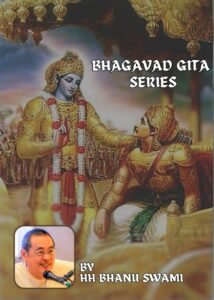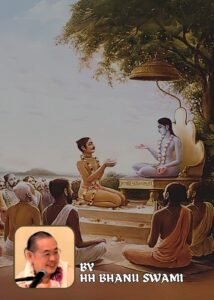Srimad Bhagavatam : 10.52.24 by HH Bhanu Swami Maharaj on Dec 2, 2024 @ ISKCON Japan
Text 24
tāṁ buddhi-lakṣaṇaudārya-
rūpa-śīla-guṇāśrayām
kṛṣṇaś ca sadṛśīṁ bhāryāṁ
samudvoḍhuṁ mano dadhe
Translation
Lord Kṛṣṇa knew that Rukmiṇī possessed intelligence, auspicious bodily markings, magnanimity, beauty, proper behavior and all other good qualities. Concluding that she would be an ideal wife for Him, He made up His mind to marry her.
Purport
Just as Lord Kṛṣṇa was described as sadṛśaṁ patim, an ideal husband for Rukmiṇī, being just like her, Rukmiṇī is described as sadṛśīṁ bhāryām, an ideal wife for Śrī Kṛṣṇa, being just like Him. That is natural, since Śrīmatī Rukmiṇī is Lord Kṛṣṇa’s internal potency.
HH Bhanu Swami Maharaj :
So, the word sadrsim, of course, means like, similar to. But here, we see in the purport is not exactly translated as ideal husband, ideal wife. Or we could say that sadrsim here means suitable.
So, Krishna felt she is suitable for him, she felt Krishna is suitable for her. So, it is obvious that they cannot be the replica. If they were, then there would only be one person. They had all the same qualities, exactly all the same powers, they would be the same person.
So, of course, Krishna does that, He expands himself into so many forms for all the queens of Dwaraka, and they’re all the same Krishna. So, we distinguish Krishna from other beings in the spiritual world and material world.
So, there must be some difference, otherwise they wouldn’t be separate. So, in the spiritual world, we have the Supreme Lord and we have Jivas. So, they are different, but they have some similar qualities.
But then we have another type which is like a Jiva, not exactly a Jiva, this is Shakti. So, in Vrindavan we have Radha, in Dwaraka we have all the queens like Rukmini, and in Vaikuntha we have Lakshmi. So, these are all different from Krishna. At the same time, there is some great similarity. And this allows for rasa. So, I mentioned yesterday, if the difference is too much, then we cannot have rasa.
When there is greater similarity, the better the rasa. So, as I said, it’s these two types who interact with Krishna, the Shakti and the Jivas. So, of course, we have two types of Jivas. We have the Baddha Jiva in the material world and we have the Jiva in the spiritual world.
So, the Jivas in the spiritual world are qualified for rasa. Jivas in the material world are not qualified for rasa. At least, not rasa with Krishna. They have rasa with each other.
So, in the spiritual world, again, among the Jivas there, we have two types. So, we have the nitya-siddhas, and we have those from the material world, with the spiritual world. But not much difference other than the fact that the origin is different.
So, there is some difference between the Shakti and the Jivas. So, the Jivas are defined by nature as being small particles of consciousness who are always dependent on the supreme Lord. Of course, we also call them Shakti. They are Tatastha Shakti. So, whether they are in the material world or in the spiritual world, they remain Tatastha Shakti. But the other type of person who interacts with the supreme lord is the Shakti, the internal Shakti.
So, some portions of that Shakti become personified as individuals like Radha. So, the internal Shakti also is always dependent on the Supreme Lord. However, this internal Shakti personified as Radha, we don’t call her a small particle like a Jiva.
And we can say that the relationship between the internal Shakti, this internal energy, and Supreme Lord is very, very close, they never separate. Of course, that Shakti may not manifest its qualities.
So, this minimal manifestation is called Brahman. And when the samvit, hladini and sandini shaktis operate together, we will get spiritual world, we get forms of the Supreme Lord and others, we get all the rasa that develops. But, in their absence, it becomes Brahman. So, in the spiritual world, then Lord is always manifested with his internal energy, with all his pastimes, etc.
So, sometimes that energy person is divided up into samvit, hladini and sandini etc. That’s one way of dividing up that energy. And then we also have a list of some of the Shaktis, like Leela Shakti, which is the Shakti to manifest pastimes.
We have Yogamaya Shakti to create maya in the spiritual world. So, there are certain of these Shaktis that become personified as personalities. For instance, Yogamaya becomes personified as Purnamasi, and Hladini Shakti becomes personified as Radha.
So, Hladini Shakti and bliss is the main quality of the Supreme Lord. So therefore, Krishna is never separated from Radha, and Vishnu is never separated from Lakshmi. So, Krishna and Radha are distinct personalities, but because it’s internal energy, they are also very close.
So, the interaction between Krishna and His Hladini Shakti creates the ultimate blissful pastimes. Of course, we can ask, well, Krishna is Atmarama, He’s enjoying in himself, He’s blissful by himself, so why does he need anybody else? So, the answer is, the highest bliss takes place through rasa. And rasa requires another person.
So, the other person would be the most qualified. The most qualified person is His internal Shakti. So, in this way, pastimes manifest in the spiritual world because of this distinction between Krishna and others. So, we have the internal energy, plus we have the Jivas in the spiritual world, again, rasa with Krishna and bliss. So, the Jivas are little more different, they’re not the internal Shakti, they’re a little more different from Krishna, they’re little small particles.
So, why would the Lord want to have a relationship with a Jiva; because they’re so different. So, material world, of course, Krishna doesn’t have a relationship with the Jivas in the material world.
The Jivas in the spiritual world are different. They have a small portion of Hladini Shakti, Samvit Shakti, this internal energy is also joined with the Jivas in the spiritual world, so they’re not exactly the same as the Jivas in the material world.
They’re two different species. There’s some difference there, we say almost completely constitutional difference. Intrinsic difference, basic difference.
So, that internal energy or the Cit Shakti which joins with the Jiva makes them very special. So, in other words, they have some more power than the Jivas in the material world. But not power in the sense of controlling, like that.
It means that they have more, let’s say, spiritual Shakti to relate with Krishna. So, because they are conscious, they are Jivas somewhat similar, and then they have that Cit Shakti to become more similar, then Supreme Lord establishes a relationship with the Jivas. So, because there are so many Jivas in the spiritual world who are perfect, etc., this allows Krishna to have a great variety of interactions, a great variety of rasa.
So, of course, these Jivas in the spiritual world with the Cit-Shakti are the same, they’re not exactly like the Cit-Shakti like Radha. They’re still a little different. But they say it’s a difference in again, the power. The amount of Cit Shakti is little different. So the Jiva can never aspire to become like Radha, because he’s constitutionally different.
However, the Supreme Lord is very merciful, and He allows those Jivas with the Cit-Shakti to participate almost as equals. And of course, Radha herself is not proud of her position of being, I’m the Hladini Shakti, you’re not.
So, she encourages all of these Jivas in the spiritual world to have a relationship with Krishna. So, Krishna is in Goloka and the spiritual world, then we have all these other expansions and other Visnu forms also. So, just as Krishna expands, the Hladini Shakti expands into Lakshmi.
In the case of Krishna, then, he’s Krishna in Goloka, but he’s also Krishna in Dwaraka. But there’s a little difference. The Shakti is there but it’s slightly different. In Vrindavan, Radha sees Krishna and interacts with him, not as the Supreme Lord.
But the queens in Dwaraka, like Rukmini, they also see Krishna as the Supreme Lord. And, of course, in Vaikuntha, Lakshmi also sees Visnu as the Supreme Lord. So, the manifestation of the Hladini Shakti in Vrindavan is considered to be superior.
So, of course, all the expansions are non-different, but at the same time, we get the highest expression of rasa with Radha and Krishna. So, there is similarity, there’s also difference. And based on similarity, we can have rasa. And the more elevated the person, the more manifestation of qualities, the more suitable they are for rasa.
OK.
Q & A:
1) What about Durga?
Well, just as Shiva is an expansion from Vishnu, and he’s also like a Vishnu form, but with less powers, so we can say that Durga is a manifestation from Lakshmi, but less powers.
However, I’ve never seen real description by Goswamis, the position of Durgadevi. But they would follow that, the most suitable consort. So Shiva is the form of God. So then Lakshmi is considered as some special personality.
2) What about all the Jivas in Spiritual world, do they have special relationship with each others, as well as with Krishna?
Yes, there must be relationships between the individual Jivas also. But that relationship never becomes predominant over the relationship with Supreme Lord.
So we see, Radha relates with Krishna, Radha relates with her Sakhis, which is not impersonal sakhis, they have all sorts of pastimes together. So all of their interactions with each other are related to their relationship with Krishna.
3) In other words, they never directly relate with each other, always through Krishna relationship ?
Yes, they may obviously speak to each other etc., but it’s always because of Krishna, something to do with Krishna. So in the story of the Rasalila, the Gopis, when Krishna disappeared and the Gopis were there looking for Krishna. They were interacting with each other. But it’s all in relation to finding Krishna.
4) Maharaj, does the origins are different for the Jivas (nitya-mukta) in spiritual world and the Jivas (nitya-bhada) in material world ?
Yeah. It has the origin, but they are different, because once they are in spiritual world, they have this Chit shakti. Once they do come to material world, they don’t.
5) We hear Jivas are from spiritual world only right, we are not separately in this world?
Well, the problem is that, if you have that Chit Shakti endowment, it becomes permanent. So it’s a very different species. However, that Jiva in the material world, as he develops bhakti, gets that endowment.
Now the Chit Shakti starts in Bhava. So in Bhava stage, it starts manifesting. Bhava itself is Hladini and Samvit Shakti. And that becomes permanently fixed in the Jiva, in Prema. And then, he’s qualified for the spiritual world.
6) So, then why we hear the story that Jiva falls down from spiritual world ?
Yes, but we also say that once you go there, you don’t fall down.
7) Maharaj said, once the Jiva goes to Spiritual world they don’t come back, but we some see cases like that?
There are cases where they come from the spiritual world, but that’s more for pastimes. So they come from the spiritual world, to the material world. That’s for pastimes. Tulsi Devi or Jaya and Vijaya. Those are special cases. And they don’t become conditioned jivas.
8) Maharaj, does the Jivas in spiritual world are eternally existing for pastimes and Jivas in material world are created ?
They’re not created. Yeah, because they have some karmas from previous creations. So that’s why they have Anadi-Karma.
9) Finally, where we come from?
We are tattasta Shakti. But there’s no coming from it, because it is eternal.
10) We’re coming from Krishna?
Not in a time sense. Because everything is depending on Supreme Lord. That’s how we come from Him. Just like the avatars come from Krishna, but they don’t come because they’re eternal also !


